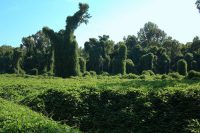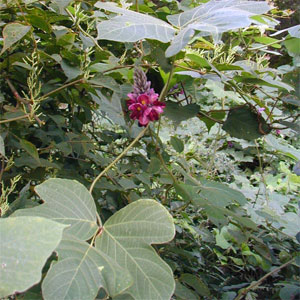If you or someone you know is one of the unfortunate 0.1% of the population who suffers from cluster headaches, take heart:an herb commonly used in Traditional Chinese Medicine and in Asian cooking may help manage the frequency of attacks and severity of pain.
A recent study completed by Yale University Doctor R. Andrew Sewell and his team shows that the herb Kudzu may be effective for treating cluster headaches. (Read the full text of Sewell’s study here.)
My readers in the southern United States may do a double take on that one. “Kudzu? The ‘vine that ate the South’?” they may ask. Yes, that dreaded vine which can advance at a rate of about 10 feet a day, covering all in its path, has a root (a giant one, I might add) that could be a godsend for sufferers of cluster headaches, whose pain is said to surpass all other human pain.
So named because they occur in clusters either classified as episodic or chronic, cluster headaches are also known as “suicide headaches” because of the excruciating severity of their pain. Episodic cluster headaches will have a remission period of a month or longer. Chronic cluster headaches occur continuously without any remission period between cycles. The condition can change from chronic to episodic or vice versa with remission periods lasting decades being known to occur.
In his report in the January 2009 edition of Headache Journal, Dr. Sewell describes how the rhizome of Kudzu (Pueraria lobata, also known in Chinese as ge gen) is detailed in classical Chinese medical texts as indicated for many conditions, including symptoms of cold, flu and fever with stiff neck, as well as alcoholism, diarrhea, hypertension and angina pectoris. Sewell’s research suggests that Kudzu also has among its effects the ability to increase cerebral flow to the brain, thus relieving headaches — including the dreaded cluster headache. The next step is a randomized clinical trial using standardized extracts to determine whether kudzu may have a role in the management of cluster headaches, as reported by many who have already found relief using this herb.
Traditional Chinese medicine (TCM) distinguishes different types of headaches as follows:
1. Acute headaches caused by external factors including
- Wind and Cold with symptoms of chills and cold sensitivity
- Wind and Heat with symptoms of chills, fever, inflammation
- Wind and dampness with symptoms of dampness (edema)
2. Chronic headaches caused by internal factors including:
- Liver Yang syndrome with symptoms of hypertension, aggressive irritability
- Kidney (adrenal and hormonal) imbalance
- Qi (energy) and Blood deficiency. Associated with a person who is nutritionally weak and run down.
- Turbid Phlegm with symptoms of dampness, phlegm, possible cough and excessive sputum.
- Blood stagnation with symptoms of fixed stabbing pain
The severity of pain in cluster headaches places this condition prominently in the category of Blood stagnation, but individual patients may exhibit more than a single syndrome and treatment is adjusted accordingly with corresponding acupuncture/acupressure and traditional Chinese herbal formulas.
The use of OTC drugs for headaches
Over-the-counter drugs such as aspirin or acetaminophen are classified as effective for mild pain and inflammation and may have a very limited use for severe migraines or cluster headaches. However the therapeutic principle is consistent with TCM theory, which states “no blockage, no pain” — in other words, aspirin’s blood-thinning properties relieve pain by releasing stagnant Blood which blocks free flow of Qi.
Aspirin, the first “wonder drug” is pure acetylsalicylic acid and was originally derived from the common herb for rheumatic pains and fever, Meadowsweet (Asperea ulmaria – thus the name “aspirin”). Acetylsalicylic acid is found in several plants with similar properties, including willow, rosemary, white poplar and wintergreen.
The significant difference between herbs containing acetylsalicylic acid and the drug aspirin is that the drug is synthesized to be the pure chemical while the herbs contain many other cofactors that may play a broader and more vital role in treatment with less chance of adverse reactions.
I’ve seen it happen many times before. An herb is found in its whole form to be effective for a specific disease but in its synthesized single chemical form it is not so effective. Because drug companies spend millions to bring a drug to market, there is no incentive to invest in an herb that can be freely found as a common noxious weed.

Kudzu Field (source: By I, Gsmith, CC BY 2.5, https://commons.wikimedia.org/w/index.php?curid=2366646)
In the meantime, Kudzu is commonly available in powdered form as a sauce thickening condiment in Japanese cooking. As stated, Kudzu, also known as Pueraria Montana, is a spreading vine with a gigantic root. It is native to Asia and was introduced in the Southeastern United States, where it encountered no natural ecological limiting growth factors. Kudzu took off, engulfing huge swaths of that part of the country, climbing telephone poles and overrunning deserted homesteads. It’s nearly impossible to eradicate.
We will have to see whether Kudzu, reported to be effective by scores of patients in Dr. Sewell’s study, finds its way through the costly pharmaceutical red tape market as well it can find its way over and through anything in its path on the Southeastern U.S. landscape. For the sake of cluster headache sufferers all over the world, I hope it does.

